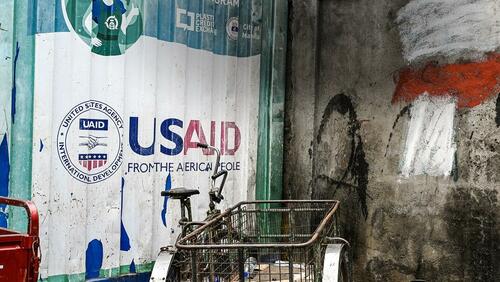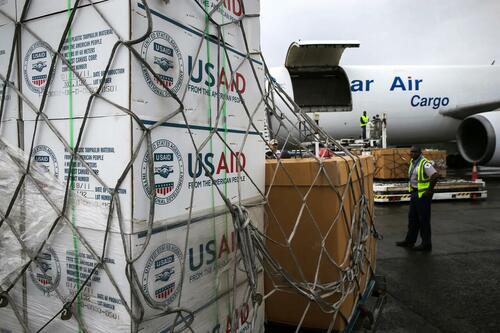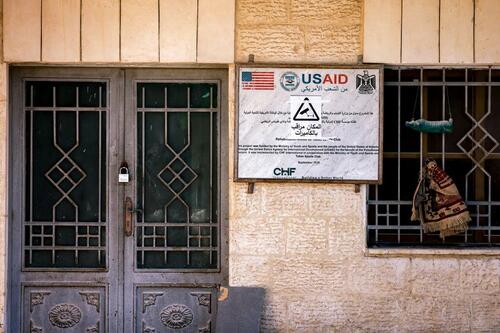
Authored by Lawrence Wilson via The Epoch Times (emphasis ours),
The U.S. Agency for International Development (USAID) was a little-noticed federal agency until it suddenly became the object of a fierce political battle over the limits of presidential power and the accountability of government bureaucracies.

When the Trump administration closed the agency’s offices on Feb. 3 and later placed most employees on administrative leave, USAID took center stage in a drama unfolding at both ends of Pennsylvania Avenue.
On one side is the Trump administration’s ongoing effort to make all parts of the executive branch comply with the president’s agenda. On the other side are congressional Democrats, who are warning that the action is a dangerous abuse of executive power and are vowing to fight it.
Meanwhile, many observers fear that USAID’s true purpose—to advance U.S. interests through the use of soft power—may be overlooked.
On Feb. 3, President Donald Trump appointed Secretary of State Marco Rubio as acting director of USAID. The next day, the president indicated that the agency may be shuttered and its functions permanently transferred to the State Department.
Here is why critics want to abolish or reform the agency, supporters want to save it, and what may happen next.
Influence as Power
USAID was established by an executive order of President John F. Kennedy in 1961 to advance U.S. foreign policy by offering developing nations technical assistance, help with education and health care, and disaster relief.
The idea was that turning poor countries into stable world citizens would benefit U.S. citizens, too. A stable, prosperous nation makes a good ally, the theory went.
Champions of USAID continue to see it as both an essential tool for foreign policy and a tangible expression of the goodness and generosity of the U.S. people.
Most observers agree that the agency does some good. Relatively small by Washington’s standards, USAID employs about 10,000 people and controls an annual budget of about $50 billion.
In 2023, USAID poured $10.5 billion into humanitarian aid and $10.5 billion into health programs in countries around the world, according to the Congressional Research Service.
One program that is often touted as a shining success story is the U.S. President’s Emergency Plan for AIDS Relief, a USAID program that has provided more than $110 billion for controlling the spread of HIV/AIDS in more than 50 countries.

“Most estimates are that somewhere in the vicinity of 27 million people are alive today because President Bush initiated and Congress supported that program,” Scott Pegg, acting director of the Global and International Studies program and chair of political science at Indiana University–Indianapolis, told The Epoch Times.
President Donald Trump said in remarks to reporters on Feb. 4 that “some of the money is well spent.”
Yet the agency’s halo dims on closer inspection. Critics tell the story of an agency gone rogue, wasting millions of taxpayer dollars on inane programs, refusing to answer basic questions from congressional committees, and actively undermining the foreign policy goals of the United States.
Lost Purpose
The White House on Feb. 3. produced a list of projects funded by USAID that it characterized as examples of waste and abuse.
The projects include $1.5 million to “advance diversity equity and inclusion in Serbia’s workplaces and business communities,” another $47,000 for a “transgender opera” in Colombia, and $2.5 million for electric vehicles in Vietnam.
Rep. Wesley Hunt (R-Texas) listed further examples on social media platform X on Feb. 3, including $56 million to boost tourism in Egypt and Tunisia and $27 million for “reintegration gift bags” for deported Central Americans.
Hunt said the agency was behaving “like a child with YOUR credit card.”
Some USAID grant recipients include terrorist-controlled organizations, according to a study by the Middle East Forum released on Feb. 1.
The study found that $122 million has gone to groups aligned with designated terrorist organizations, including millions of dollars for organizations directly controlled by the Hamas terrorist group.
A July 2024 report from the U.S. Office of Inspector General noted deficiencies and vulnerabilities in USAID’s vetting process, which is supposed to prevent the diversion of U.S. funds to terrorist organizations.
In one case of apparent abuse, USAID partnered with Chemonics, an international consulting firm, to spend $9.5 billion to improve health supply chains. Chemonics allegedly overbilled the agency by up to $270 million and failed to meet its objectives, and the project led to 31 indictments for the illegal resale of USAID-funded materials, according to Sen. Joni Ernst (R-Iowa), who has called for an independent analysis of USAID grant recipients.

Ernst said USAID also provided nearly $1 million in funding to China’s Wuhan Institute of Virology, which the CIA has said was the most likely source of the virus that causes COVID-19.
USAID has resisted congressional oversight for decades, some lawmakers say, resulting in a culture of defiance.
“The agency has engaged in a demonstrated pattern of obstructionism,” Ernst wrote in a letter to Rubio on Feb. 4.
False claims were made that certain documents were classified to delay review by congressional staffers and to mislead Congress on the indirect cost of programs, Ernst wrote, adding that in some cases, this amounted to more than 25 percent of the grant total.
The agency refused to provide data on administrative costs, Ernst said. The agency later said that providing the data to Congress would violate federal law and that it had no obligation to respond because Ernst did not present a formal request from a “committee of jurisdiction.”
Read the rest here...
Authored by Lawrence Wilson via The Epoch Times (emphasis ours),
The U.S. Agency for International Development (USAID) was a little-noticed federal agency until it suddenly became the object of a fierce political battle over the limits of presidential power and the accountability of government bureaucracies.

When the Trump administration closed the agency’s offices on Feb. 3 and later placed most employees on administrative leave, USAID took center stage in a drama unfolding at both ends of Pennsylvania Avenue.
On one side is the Trump administration’s ongoing effort to make all parts of the executive branch comply with the president’s agenda. On the other side are congressional Democrats, who are warning that the action is a dangerous abuse of executive power and are vowing to fight it.
Meanwhile, many observers fear that USAID’s true purpose—to advance U.S. interests through the use of soft power—may be overlooked.
On Feb. 3, President Donald Trump appointed Secretary of State Marco Rubio as acting director of USAID. The next day, the president indicated that the agency may be shuttered and its functions permanently transferred to the State Department.
Here is why critics want to abolish or reform the agency, supporters want to save it, and what may happen next.
Influence as Power
USAID was established by an executive order of President John F. Kennedy in 1961 to advance U.S. foreign policy by offering developing nations technical assistance, help with education and health care, and disaster relief.
The idea was that turning poor countries into stable world citizens would benefit U.S. citizens, too. A stable, prosperous nation makes a good ally, the theory went.
Champions of USAID continue to see it as both an essential tool for foreign policy and a tangible expression of the goodness and generosity of the U.S. people.
Most observers agree that the agency does some good. Relatively small by Washington’s standards, USAID employs about 10,000 people and controls an annual budget of about $50 billion.
In 2023, USAID poured $10.5 billion into humanitarian aid and $10.5 billion into health programs in countries around the world, according to the Congressional Research Service.
One program that is often touted as a shining success story is the U.S. President’s Emergency Plan for AIDS Relief, a USAID program that has provided more than $110 billion for controlling the spread of HIV/AIDS in more than 50 countries.

“Most estimates are that somewhere in the vicinity of 27 million people are alive today because President Bush initiated and Congress supported that program,” Scott Pegg, acting director of the Global and International Studies program and chair of political science at Indiana University–Indianapolis, told The Epoch Times.
President Donald Trump said in remarks to reporters on Feb. 4 that “some of the money is well spent.”
Yet the agency’s halo dims on closer inspection. Critics tell the story of an agency gone rogue, wasting millions of taxpayer dollars on inane programs, refusing to answer basic questions from congressional committees, and actively undermining the foreign policy goals of the United States.
Lost Purpose
The White House on Feb. 3. produced a list of projects funded by USAID that it characterized as examples of waste and abuse.
The projects include $1.5 million to “advance diversity equity and inclusion in Serbia’s workplaces and business communities,” another $47,000 for a “transgender opera” in Colombia, and $2.5 million for electric vehicles in Vietnam.
Rep. Wesley Hunt (R-Texas) listed further examples on social media platform X on Feb. 3, including $56 million to boost tourism in Egypt and Tunisia and $27 million for “reintegration gift bags” for deported Central Americans.
Hunt said the agency was behaving “like a child with YOUR credit card.”
Some USAID grant recipients include terrorist-controlled organizations, according to a study by the Middle East Forum released on Feb. 1.
The study found that $122 million has gone to groups aligned with designated terrorist organizations, including millions of dollars for organizations directly controlled by the Hamas terrorist group.
A July 2024 report from the U.S. Office of Inspector General noted deficiencies and vulnerabilities in USAID’s vetting process, which is supposed to prevent the diversion of U.S. funds to terrorist organizations.
In one case of apparent abuse, USAID partnered with Chemonics, an international consulting firm, to spend $9.5 billion to improve health supply chains. Chemonics allegedly overbilled the agency by up to $270 million and failed to meet its objectives, and the project led to 31 indictments for the illegal resale of USAID-funded materials, according to Sen. Joni Ernst (R-Iowa), who has called for an independent analysis of USAID grant recipients.

Ernst said USAID also provided nearly $1 million in funding to China’s Wuhan Institute of Virology, which the CIA has said was the most likely source of the virus that causes COVID-19.
USAID has resisted congressional oversight for decades, some lawmakers say, resulting in a culture of defiance.
“The agency has engaged in a demonstrated pattern of obstructionism,” Ernst wrote in a letter to Rubio on Feb. 4.
False claims were made that certain documents were classified to delay review by congressional staffers and to mislead Congress on the indirect cost of programs, Ernst wrote, adding that in some cases, this amounted to more than 25 percent of the grant total.
The agency refused to provide data on administrative costs, Ernst said. The agency later said that providing the data to Congress would violate federal law and that it had no obligation to respond because Ernst did not present a formal request from a “committee of jurisdiction.”
Read the rest here…
Loading…





